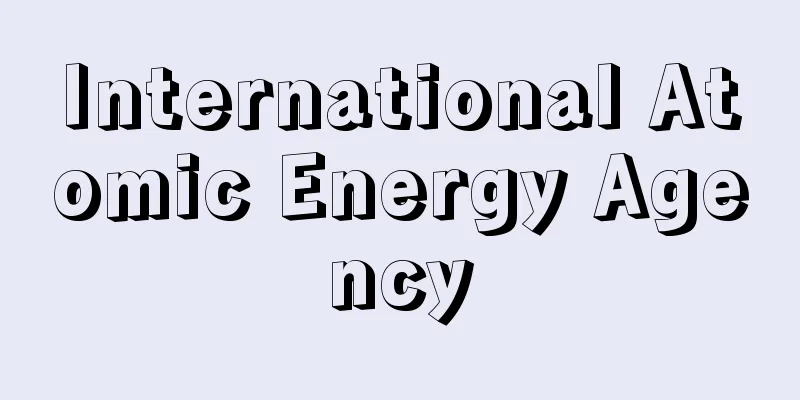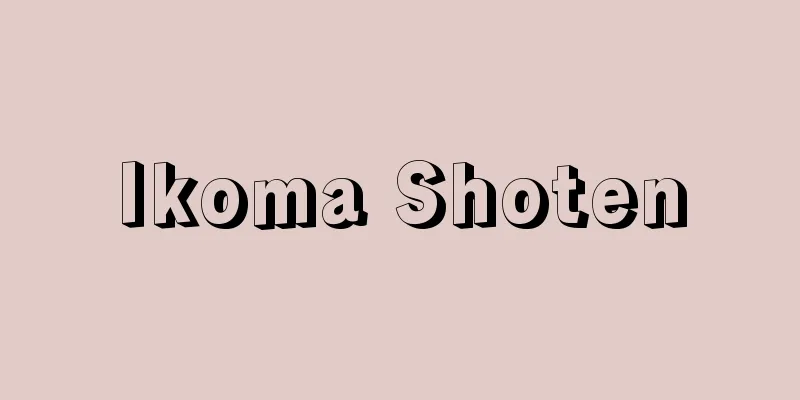International Atomic Energy Agency

|
Abbreviation: IAEA. An international cooperation organization established in 1957 based on its own charter (IAEA Charter) to prevent military use of atomic energy and promote peaceful uses. It was launched based on the proposal of "Atoms for Peace" in a speech by then US President Eisenhower at the UN General Assembly in 1953. It is headquartered in Vienna, and as of December 2009, it has 151 member countries. It is a specialized international organization that operates on a global scale, but since it deals with areas that are closely related to security, it has a stronger relationship with the Security Council than with the Economic and Social Council. For this reason, it is not a specialized agency of the UN. Its main organs are the General Assembly, the Council, and the Secretariat. Japan has been a member since its establishment and is a designated member state. [Yokota Yozo] Main businessFor the peaceful uses of atomic energy, the IAEA's activities include encouraging research, development and practical applications, facilitating the procurement of services, materials and facilities for these purposes, encouraging the exchange of information and the training of experts, applying safeguards, and setting safety standards. Of the IAEA's activities, the one that is particularly distinctive and of practical importance is safeguards, which are intended to prevent materials produced through the operation of peaceful facilities such as nuclear power plants from being diverted for military purposes. Specifically, the following six methods are used: (1) Bilateral safeguards implemented based on a bilateral implementing agreement between the IAEA and a Member State. (2) Unilateral safeguards implemented by the IAEA at the request of a Member State. (3) tripartite safeguards administered by the IAEA under nuclear agreements between the United States and countries that provide nuclear materials, such as nuclear fuel, and the countries that receive them. (4) Safeguards implemented pursuant to agreements between the IAEA and the contracting parties to regional multilateral treaties, such as the 1967 Treaty on the Prohibition of Nuclear Weapons in Latin America (Treaty of Tlatelolco). (5) Safeguards implemented under the 1968 Treaty on the Non-Proliferation of Nuclear Weapons (NPT) through agreements between the Contracting Parties and the IAEA. (6) Safeguards are measures implemented based on agreements voluntarily concluded between the nuclear-weapon states that are members of the NPT (the United States, the United Kingdom, France, Russia, and China) and the IAEA. [Yokota Yozo] Activities since the 1980sA conference of experts was held to investigate the causes and effects of the Chernobyl nuclear power plant accident that occurred in the Ukrainian Republic, then part of the Soviet Union, in April 1986. At the general assembly in September of the same year, the establishment of an early notification system for nuclear accidents was discussed, and two treaties on "early notification" and "mutual assistance" were adopted. The IAEA has repeatedly conducted nuclear inspections of Iraq since 1991, based on UN Security Council resolutions. Inspections were suspended in December 1998 due to air strikes on Iraq by US and British forces, but were resumed by the IAEA and the UN Inspection Committee in November 2002. However, in March 2003, US and British forces used force against Iraq with the aim of disarming Iraq and overthrowing the Hussein regime (Iraq War), and the Hussein regime collapsed in April of the same year. Meanwhile, regarding the nuclear issue of North Korea, which withdrew from the IAEA in June 1994, high-ranking officials of the United States and North Korea decided in October of the same year to freeze North Korea's nuclear development, fully return to the NPT, and support the conversion to light-water reactors, and the Korean Peninsula Energy Development Organization (KEDO) was launched in March 1995 to provide concrete support. KEDO agreed to provide heavy oil to North Korea until the construction of the light-water reactor was completed, but in October 2002, North Korea admitted to its nuclear development plans, and in November it announced that it would stop providing heavy oil unless North Korea abandoned its nuclear development, and the provision was halted in December. North Korea subsequently declared that it would lift the freeze on its nuclear-related facilities, and expelled the IAEA inspectors stationed there. Since 2003, six countries - Japan, the United States, South Korea, China, Russia, and North Korea - have been holding talks to resolve various issues surrounding North Korea, including the nuclear issue (the Six-Party Talks, also known as the Six-Party Talks or the Six-Party Talks), and at the Six-Party Talks in February 2007, North Korea announced that it would accept inspections by the IAEA, and in June of that year, an IAEA inspection team led by Deputy Director-General Heinonen visited North Korea and inspected its nuclear facilities. The following July, IAEA inspectors visited North Korea for the first time in about four and a half years, and confirmed the suspension of operations at all five facilities that had been the subject of the Six-Party Talks. In 1998, Japan issued a statement calling for restraint from India and Pakistan, which had conducted nuclear tests in May of that year. In 1999, Japan dispatched a team of experts to investigate the criticality accident in Tokaimura, Ibaraki Prefecture. In recognition of these efforts "to prevent military uses of nuclear energy and to ensure as far as possible its peaceful uses," the IAEA and its Director General, ElBaradei, were awarded the Nobel Peace Prize in 2005. [Yokota Yozo] "Nuclear Proliferation Prevention Glossary - Explanation of IAEA Safeguards-related Terms" edited by the Nuclear Material Control Center Planning Department and supervised by the Science and Technology Agency Nuclear Safety Bureau Safeguards Division (1981, Nuclear Material Control Center)" ▽ "IAEA Inspections and Nuclear Proliferation" by Takayoshi Imai (1994, Nikkan Kogyo Shimbun) [References] | | | | |Source: Shogakukan Encyclopedia Nipponica About Encyclopedia Nipponica Information | Legend |
|
略称IAEA。原子力の軍事的利用を防止し、平和的利用を促進するために、独自の憲章(IAEA憲章)に基づいて1957年に設立された国際的協力機構。1953年の国連総会で、当時のアメリカ大統領アイゼンハワーが演説した「平和のための原子力Atoms for Peace」の提案をもとに発足した。ウィーンに本部を置き、2009年12月時点での加盟国数は151か国。世界規模で活動する専門的国際機構であるが、安全保障に深い関係がある分野を扱うことから、国連では経済社会理事会よりは安全保障理事会との関係が強い。そのために国連の専門機関とはなっていない。主要機関として総会、理事会および事務局がある。日本は設立当初より加盟しており、指定理事国となっている。 [横田洋三] おもな業務原子力の平和的利用のために、研究・開発・実用化の奨励、そのための役務・物質・施設の確保に対する便宜の供与、情報交換および専門家の訓練の奨励、保障措置の適用、安全基準の設定などの活動を行う。IAEAの活動のなかでもとりわけ特色があり、かつ実際上の重要性をもつのは、原子力発電所などの平和的利用施設の使用によって生ずる物質が軍事目的に転用されないようにするための保障措置safeguardsである。具体的には以下の六つの方法がとられている。 (1)IAEAと加盟国との間の2当事者間の事業実施協定に基づいて行う2当事者間保障措置。 (2)加盟国からの要求によってIAEAが行う一方的保障措置。 (3)核燃料のような原子力資材を提供するアメリカとそれらを受け取る国との間の、原子力協定に基づいてIAEAが行う3当事者間保障措置。 (4)1967年のラテンアメリカ核兵器禁止条約(トラテロルコ条約)などの、地域的多数国間条約の締約国とIAEAとの間の協定に基づいて行われる保障措置。 (5)1968年の核不拡散条約(NPT)に基づいてその締約国とIAEAとの間に協定を結んで行われる保障措置。 (6)NPT加盟の核兵器保有国(アメリカ、イギリス、フランス、ロシア、中国)が自発的にIAEAと協定を結び、それに基づいて行われる保障措置。 [横田洋三] 1980年代以降の活動1986年4月、ソ連邦を構成していたウクライナ共和国で発生したチェルノブイリ原子力発電所事故については、原因と影響を究明するための専門家会議を開催。同年9月の総会で原子力事故の早期通報システムの確立が協議され、「早期通報」「相互援助」の2条約が採択された。 IAEAは1991年以降、国連安保理決議に基づきイラクの核査察を繰り返し実施した。1998年12月アメリカ、イギリス両軍によるイラク空爆によって中断していた査察は、2002年11月IAEAと国連査察委員会によって再開された。しかし2003年3月アメリカ、イギリス両軍がイラクの武装解除とフセイン政権打倒を目的にイラクに武力行使し(イラク戦争)、同年4月フセイン政権は崩壊している。 一方、1994年6月にIAEAを脱退した北朝鮮の核問題については、同年10月の米朝高官協議で北朝鮮の核開発凍結とNPTへの完全復帰、軽水炉転換への支援などが決まり、具体的支援のため朝鮮半島エネルギー開発機構(KEDO(ケドー))が1995年3月に発足した。KEDOは軽水炉建設が完成するまでの間、北朝鮮に重油の提供をするとしたが、2002年10月北朝鮮が核開発計画を認めたことなどから、11月核開発を放棄しない場合は重油の提供を停止すると発表、12月提供は停止された。その後北朝鮮は核関連施設の凍結措置を解除すると宣言、駐在していたIAEA査察官を国外退去させた。2003年より核問題を含めた北朝鮮をめぐる諸問題の解決に向け、日本、アメリカ、韓国、中国、ロシア、北朝鮮の6か国で協議が進められ(六者協議。六か国協議、六者会合ともいう)、2007年2月の六者協議で北朝鮮はIAEAの査察受け入れを表明、同年6月に事務次長ハイノネンを団長とするIAEA査察団が訪朝して核施設の視察を行った。翌7月には約4年半ぶりにIAEA査察官が訪朝、六者協議で対象となった全5施設の稼動停止を確認した。 1998年には、同年5月に核実験を行ったインドとパキスタン両国に対し、自制を求める声明を発表。1999年に起きた茨城県東海村の臨界事故に関しては、現地調査の専門家チームを派遣した。 こうした活動が、「核エネルギーの軍事的利用を防ぎ、平和利用を可能なかぎり確実にしてきた」と評価され、2005年、IAEAとその事務局長であるエルバラダイにノーベル平和賞が授与された。 [横田洋三] 『核物質管理センター企画部編、科学技術庁原子力安全局保障措置課監修『核拡散防止用語集――IAEA保障措置関係用語の解説』(1981・核物質管理センター)』▽『今井隆吉著『IAEA査察と核拡散』(1994・日刊工業新聞社)』 [参照項目] | | | | |出典 小学館 日本大百科全書(ニッポニカ)日本大百科全書(ニッポニカ)について 情報 | 凡例 |
<<: International Language - Kokusaigo
>>: International Atomic Time - International Atomic Time
Recommend
Half-sleeve - Hashitomi
Noh piece. Third piece. Five-school contemporary ...
Absolute - Zettaisha (English spelling) absolute English
The opposite concept of the relative. It means so...
Berry, Chuck
Born October 18, 1926 in St. Louis, Missouri [Died...
Crime of publishing false information
…Election interference crimes include the crime o...
Purism
…Born in Saint-Quentin. He started out as a Cubis...
Kagoshima Main Line - Kagoshima Main Line
The name of the Kyushu Railway Company (JR Kyushu...
Norisuke Akamatsu
A military commander during the Northern and Sout...
Xipacná (English spelling) Xipacna
…(2) Legends of giants as violent ancient gods wh...
Ticino (River)
A river that flows through Switzerland and Italy, ...
Press-in tonometer - Press-in tonometer
… [Measurement of intraocular pressure] In the da...
Barbad (English spelling)
…In biographical literature, the well-known work ...
Eggleton, P.
…It is also called phosphocreatine and is one of ...
Great Bearded Bat - Great Bearded Bat
...It flies slowly flapping its wings at a low al...
High pressure - Koukiatsu
At the same altitude, an area with higher pressur...
Mirror glass - Kyomengarasu
...In addition, when there are many glass areas, ...









